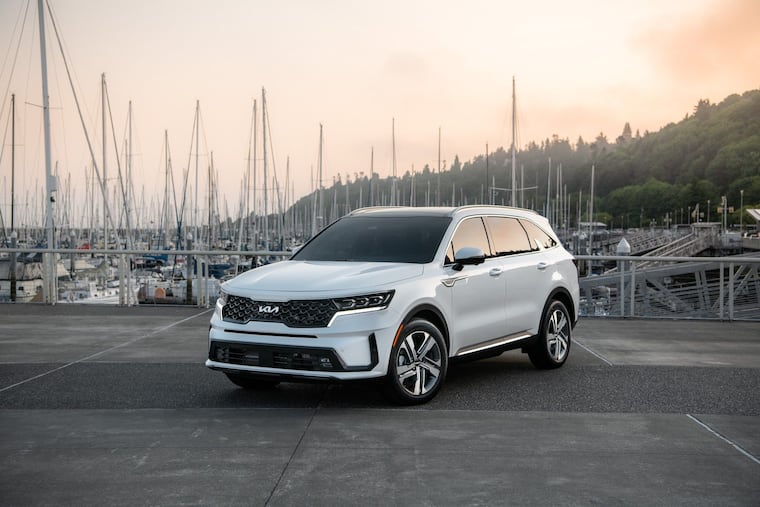2022 Kia Sorento Plug-In vs. Chevrolet Traverse: Fun and economy or space and comfort?
It seems you cannot have it all when picking among midsize three-row SUVs. Still, has the new plug-in hybrid Kia Sorento gotten closer?

2022 Kia Sorento PHEV SX-Prestige AWD vs. 2022 Chevrolet Traverse High Country AWD: Once among the least-liked SUVs tested; how do they fare now?
This week: Kia Sorento
Price: $49,720 as tested. White paint adds $445 (Mrs. Passenger Seat called it “A really nice color,” and she’s not a fan of white) and floor mats are an extra $210.
Conventional wisdom: Car and Driver likes the “32 miles of EV range, tax credit can offset the higher MSRP, three rows of seats” but not the “worse EPA combined gas mileage than the Sorento Hybrid, underpowered in EV mode, carries lots of extra weight.”
Marketer’s pitch: “Let the adventures begin.”
Reality: I have to admit, it’s getting better.
What’s new: The Sorento has missed out on Kia’s usual magic redesign touches over the years, but finally the company waved the wand for the 2021 model year. Now this plug-in hybrid version aims to add to the magic.
Up to speed: The 1.6-liter four-cylinder engine combines with an electric motor to create 261 horsepower, and the motor offers 32 miles of electric range. It makes the three-row Sorento feel spry and peppy, and gets the vehicle to 60 mph in 7.6 seconds according to Car and Driver.
Shifty: The six-speed transmission brings a touch of old school to the modern hybrid. I detected momentary hesitation now and again — pulling out, flooring it, changing speeds — and I’d put the blame on the transmission.
Still, it mostly functions well and got plenty of testing on the highway, in the city, and in the country.
A dial shifter is an unwelcome change, but it does work via clockwise-Drive and counterclockwise-Reverse twist motions, which seem less prone to problems than a simple PRNDL dial.
Paddle shifters provide some control for shifting, but a delay in engagement sapped a bit of joy from the test drive.
On the road: One place Kia has made great strides in the Sorento is road feel. Gone is the sloppy, hoppy hog that jostled me to and fro on wavy country roads. The ride is far smoother than previous generations of the Sorento, on the highway and when the road gets narrower.
Curves are not fun and there’s a bit of body roll when it’s pushed, but the Sorento will oblige mostly obediently. Still, the Sorento makes a nice companion on more sedate country roads, feeling like a sport wagon more than an SUV.
Driver’s Seat: Once marred by a bevy of confusing controls, an oddly angled seat, and hard-to-see functions, the Sorento I tested had a beautiful interior with seamless controls.
The seat isn’t exactly aaah-inducing at first, but it does provide the comfort and support one hopes for, at least way up here in the top-tier Sorento — in cheaper versions, your mileage may vary. But, as a bonus, it feels as if it’s facing the steering wheel and pedals.
Friends and stuff: Speaking of not-ahhh-inducing, the third row will make all but the shortest occupants want to weep. Mr. Driver’s Head firmly contacted the ceiling, while Mr. Driver’s Knees became acquainted with Mr. Driver’s Chest.
Meanwhile, the middle-row captain’s chairs adjusted the whole way forward, so those occupants are unhappy, too.
Getting there is most of the fun, though. A power folding seat makes access to the third row fairly easy.
Cargo space is minimal, as the third row sits pretty much up against the glass of the hatch. That translates to 12.3 cubic feet. The rear rows fold flat for a great cargo space shape. Behind the second row is 45 cubic feet, and 75.5 with everything folded down.
Play some tunes: A nice 10.25-inch touchscreen stands on the dash like a bolted-on iPad, and dials for volume and tuning make the controls simple for operation on the fly. Kia worked out an easy touchscreen menu years ago and is smart enough not to fool around with it.
Though I’d given the Bose premium auto an A in a test of a 2021 N Line version, I couldn’t match that sound quality this time around. Maybe I missed an adjustment.
Keeping warm and cool: Toggles control temperature and buttons control everything else. It functions easily and is easy to follow on the fly, as well. Vents are divided into bottom third and top two-thirds for added adjustment, a nice touch.
Fuel economy: I had the Sorento for a week of trips that made the most of electric power for my driving. And plentiful, easy-to-find trip information made it clear that I averaged about 45 mpg in my 150 miles of testing, while the vehicle averaged 26 mpg over 850 miles (before and during my testing).
Where it’s built: Hwaseong, South Korea
How it’s built: The Sorento gets a predicted reliability of 1 out of 5 from Consumer Reports, but based on previous years, not on actual tests. The model has had some other 1′s in previous years.
In the end: The Sorento Hybrid moves quickly, drives nicely, and saves fuel. But space is tight and it’s pretty expensive. And, oh, that reliability.
Next week: How will the Traverse fare?
Weight a minute: Last week’s Nissan Frontier column reversed payload and towing number. Payload is limited to 1,600 pounds, while towing is 6,700 pounds max in a 2wd version.